Key Takeaways:
- The Ritchey Chrétien telescope, part of the Cassegrain system, overcomes coma and spherical aberration with hyperbolic mirrors, improving off-axis clarity in reflecting telescopes.
- Developed by George Ritchey and Henri Chrétien in 1910, the RC telescope uses hyperbolic mirrors to enhance image quality for astronomical observations.
- Unlike traditional reflecting telescopes, it avoids spherical aberration, ensuring consistent image quality across a broader field of view.
- The Ritchey Chrétien telescope requires precise alignment and maintenance due to its complex mirror shapes, which are more challenging and expensive to produce.
Introduction to Ritchey Chrétien Telescope
The Ritchey–Chrétien telescope is a type of reflecting telescope that belongs to the Cassegrain optical system. It was designed by George Ritchey and Henri Chrétien in 1910, and is named after the initials of both men’s names. The Ritchey Chrétien telescope is a specialized variant of the Cassegrain telescope that uses a primary hyperbolic mirror (primary mirror) and a second hyperbolic mirror (secondary mirror) designed to eliminate off-axis optical errors (coma). The Ritchey Chrétien telescope has a wider field of view and fewer optical errors than that of traditional reflecting telescopes. This telescope design also eliminates chromatic aberration, which is a natural advantage over refracting telescopes.
Additionally, reflective telescopes are usually metal-coated, allowing for the use of wavelengths across both visible and infrared bands. As a result, the vast majority of astronomical telescopes use a reflective design. The Ritchey-Chrétien telescope design is well-known for its application in the Hubble Space Telescope, where it has enabled groundbreaking observations of the cosmos.
Reflecting telescope
Newton’s first reflective telescope used a spherical mirror. However, spherical mirrors are well known to have spherical aberration, which is proportional to the third power of the aperture size, limiting both the F-number and the level of image quality. Spherical mirrors offer numerous rotational symmetry axes, resulting in uniform image quality across the field of view. They are particularly suitable for systems with small relative aperture and low image quality requirements. The spot pattern of the Newton telescope with F=8.3 is presented below. However, due to spherical aberration, the image quality of the entire field of view is not ideal.
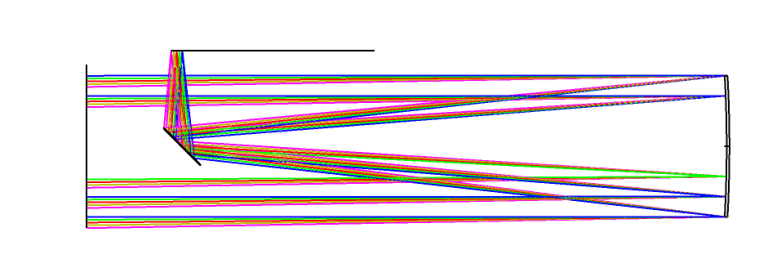
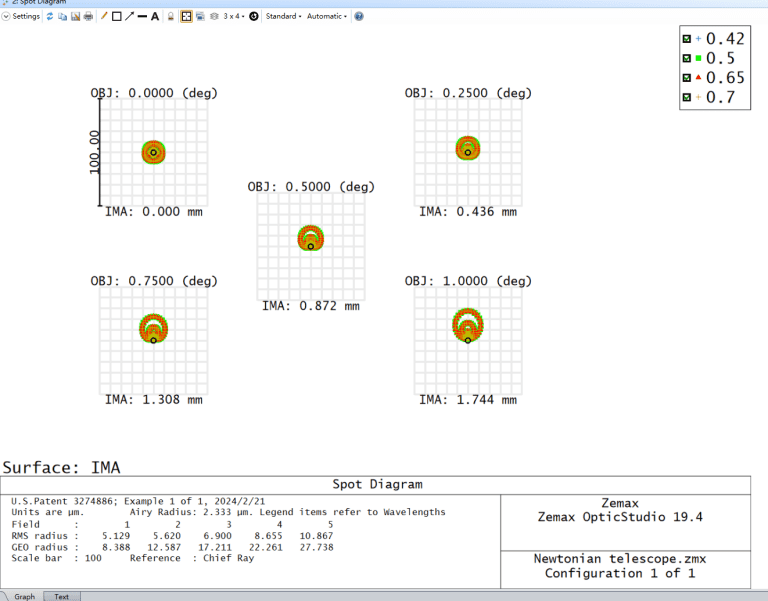
F=100mm, F=8.3, spot of Newton telescope
Cassegrain System & Ritchey Chrétien Telescope
In the face of the spherical aberration problem of reflective telescopes, optical designers have proposed different methods to improve optical design of telescopes, and various variants have been born. The most classic design is to add a convex mirror, which not only compresses the length of the structure, but also increases the freedom to improve the image quality because of the introduction of the convex mirror. This structure is called the Cassegrain system, as shown below. The Cassegrain system utilizes two mirrors: a concave primary mirror and a convex secondary mirror. The secondary mirror, while essential for focusing light, partially obstructs the incoming beam. The degree of obstruction is quantified by the light-blocking coefficient, defined as the ratio of the obstructing diameter to the input beam diameter. A high light-blocking coefficient leads to significant energy loss and degradation of image quality. Therefore, careful consideration should be given to selecting an appropriate blocking ratio during design.
Classical Cassegrain telescopes typically employ a paraboloidal primary mirror, which, due to its equal optical path length, effectively eliminates spherical aberration. However, the paraboloid’s single axis of rotational symmetry introduces challenges when light rays are not perfectly perpendicular. This off-axis incidence leads to coma, which worsens with an increasing field of view. Additionally, astigmatism and field curvature further degrade image quality away from the central axis. Consequently, while axial image quality is excellent, off-axis performance suffers, limiting the usable field of view. For instance, the following figure illustrates an F=8.3 Cassegrain telescope where, despite achieving the diffraction limit on-axis, off-axis aberrations, particularly coma, are evident.
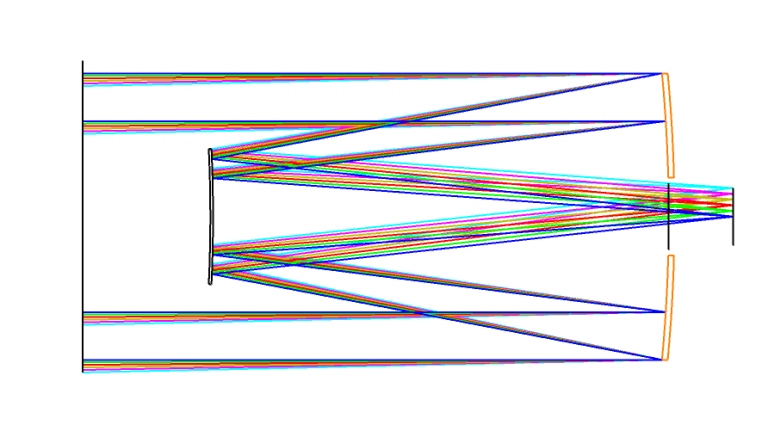
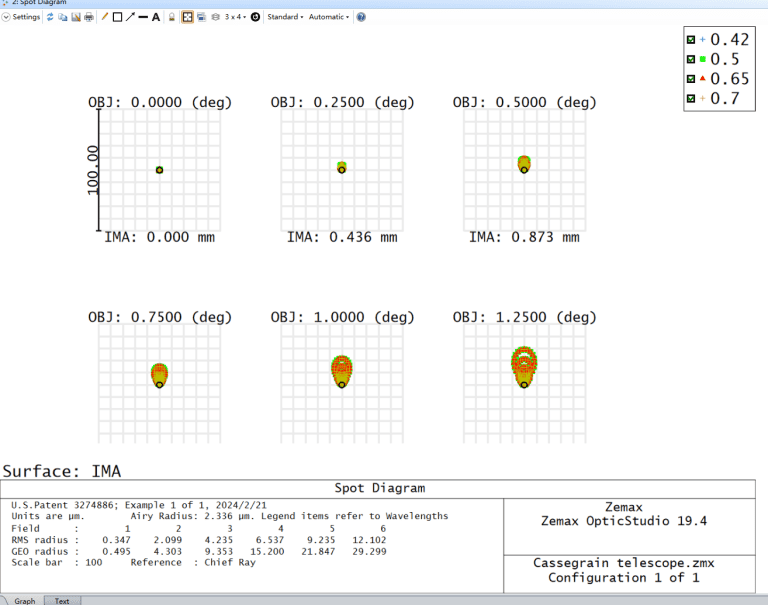
Based on the Cassegrain system, the Ritchey Chrétien telescope was born by using hyperboloid as the face type of the primary mirror and the secondary mirror. The Ritchey Chrétientelescope eliminates most of the spherical aberrations and comas, and although the on-axis image mass is slightly reduced compared to parabolic reflection systems, the reduction is not significant. Since the coma is eliminated, the off-axis image quality of the RC telescope is improved and the image quality is uniform. However, the RC telescope has not solved the problem of field curvature and astigmatism, and the light spot generally expands elliptically as the field of view increases. The field of view of the RC telescope is increased relative to the paraboloid-Cassegrain system, but it is also limited, as shown below:
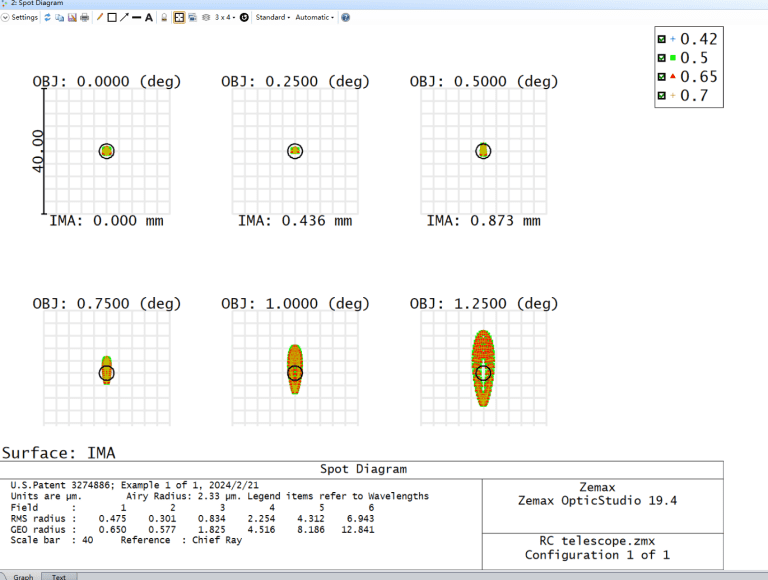
For applications requiring a large field of view, a field lens can also be added in front of the image field of the Ritchey Chrétien telescope to correct aberrations such as field curvature and astigmatism, which can further improve the image quality. The following image shows the Ritchey Chrétien telescope with two pieces of flat field lens, and the image quality is relatively good throughout the 1.25° half field of view.
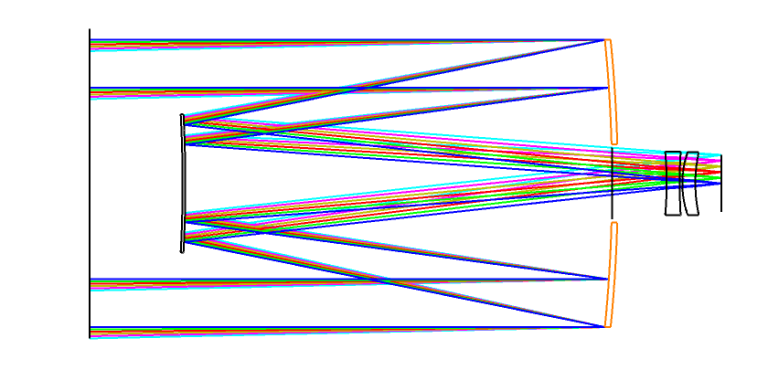
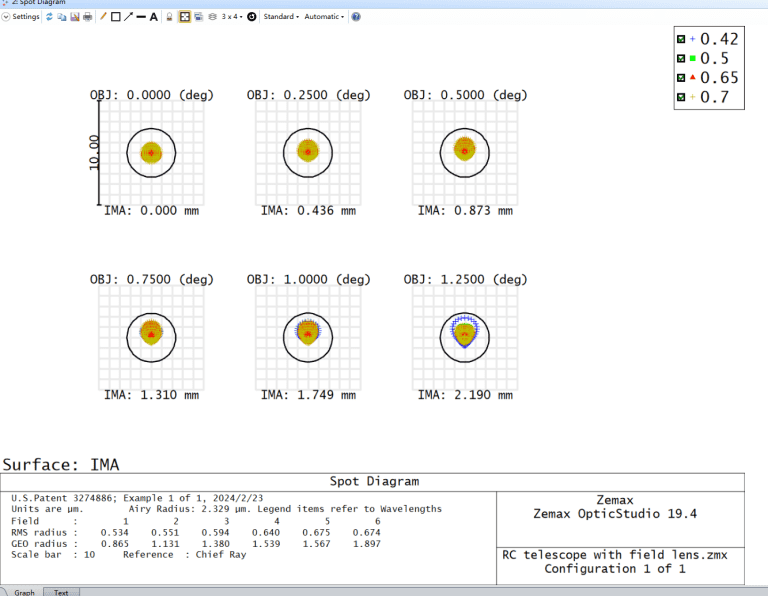
Ritchey Chrétien Telescope Summary
Ritchey Chrétien telescopes are reflector telescopes with hyperboloid for both primary and secondary mirrors. Compared to other forms of Cassegrain systems, the relative aperture of Ritchey Chrétien telescopes can be larger, usually between F6-F10. The image quality on the axis can easily reach the diffraction limit, and in a given field of view, the image quality off the axis can also be well maintained, and the image quality of the larger field of view can be further improved with the compensating lens.
The Ritchey Chrétien telescope also has some drawbacks. The inherent design of Ritchey-Chrétien (RC) telescopes, like all reflectors, results in a central obstruction, leading to some energy loss. Additionally, the RC configuration is susceptible to significant aberrations if the optical axes of the primary and secondary mirrors are not precisely aligned. This necessitates meticulous installation and ongoing maintenance to ensure optimal performance. In addition, both the primary and secondary mirrors of Ritchey Chrétien telescopes are hyperbolic, which is relatively difficult to process and more expensive than spherical or other forms of reflectors.
The Ritchey Chrétien telescope is a design with both advantages and disadvantages, but ultimately it has played an important role in some special fields, especially astronomical observation.
GREAT ARTICLE!
Share this article to gain insights from your connections!

